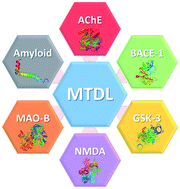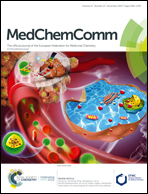Current and emerging therapeutic targets of alzheimer's disease for the design of multi-target directed ligands
Abstract
Alzheimer's disease (AD) is the most prevalent neurodegenerative disease, and a major cause of death worldwide. The number of people suffering from this debilitating disorder is rising at an unprecedented rate, with a subsequent surge in healthcare costs. Only four drugs are clinically available for the treatment of AD symptoms, but they are not disease-modifying. Consequently, there is an urgent need for a cure. Although the cause of this debilitating condition remains poorly understood, it is believed that several factors may be involved in combination – including, health and lifestyle, environmental, and genetic factors. In recent years, a number of hallmarks of the disease have also been discovered, and it is believed that these factors may play an important role in the development of AD. Amyloid aggregation is one such factor which has been highly investigated, in addition to cholinesterase enzymes and tau aggregation. In the last decade, multi-target drugs have been increasingly investigated for their application to AD treatment. By combining two or more pharmacophores in a single compound, it is possible to synthesise a drug which can target several factors that are involved in AD development. This is a particularly attractive approach as it would avoid the use of combination therapies. As a result, it could reduce the burden on carers and families, and decrease healthcare and social care costs. Many active pharmacophores have been employed for the development of hybrid drugs, due to their abilities to inhibit the factors currently widely recognised to be involved in AD. These compounds have demonstrated promising results; however, research is still required to optimise the pharmacological profiles of the drugs, in addition to their potencies. Meanwhile, extensive research is continuously being performed into other potential targets for the treatment of AD. Based on the results obtained thus far, it is likely that multi-target compounds will continue to be increasingly studied in the future as potential treatments for AD.



 Please wait while we load your content...
Please wait while we load your content...